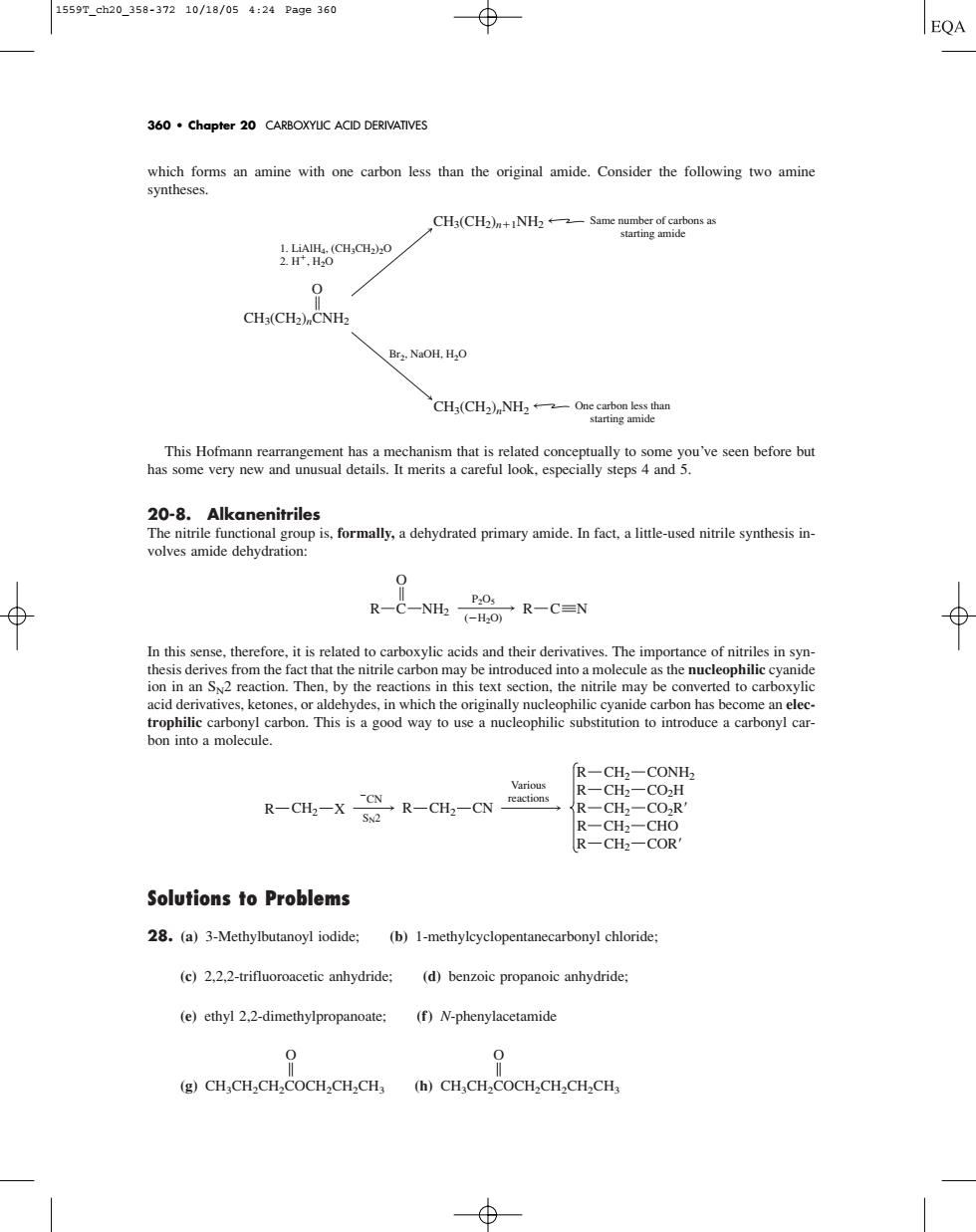正在加载图片...

1559Tch20359-37210/18/054:24Page360 360.Chapter 20 CARBOXYUC ACID DERIVATIVES CH(CH2+NH2←一Saem HAOCH.CINO 0 CH.(CH2)CNH Br.NaOH.H.O CH,CH.NH,一-oe This Hofmann re nt has a mechanism that is related cond otually to s The nitrile functional g up is,formally,a dehydrated primary amide.In fact.a little-used nitrile synthesis in- volves amide dehydration: ⊕ R-C-NH:O R-C-N In this arboxvlic acids and their derivatives The n by the nitrile may be conve d to carboxyli trophilie arbonyl earbon.Thisisa good wayto use substitution to introducea carbonyl car bon into a molecule. R-CH2-CONH R一CH-CHO R一CHh-COR Solutions to Problems 28.(a)-Methylbutanoyl iodide: (b)1-methylcyclopentanecarbonyl chloride (e)2.2.2-trifluoroacetic anhydride: (d)benzoic propanoic anhydride (e)ethyl 2.2-dimethylpropanoate: (f)N-phenylacetamide (g)CH-CH-CH-COCH CH-CH h)CHCH-COCH-CH-CH-CH Φwhich forms an amine with one carbon less than the original amide. Consider the following two amine syntheses. This Hofmann rearrangement has a mechanism that is related conceptually to some you’ve seen before but has some very new and unusual details. It merits a careful look, especially steps 4 and 5. 20-8. Alkanenitriles The nitrile functional group is, formally, a dehydrated primary amide. In fact, a little-used nitrile synthesis involves amide dehydration: In this sense, therefore, it is related to carboxylic acids and their derivatives. The importance of nitriles in synthesis derives from the fact that the nitrile carbon may be introduced into a molecule as the nucleophilic cyanide ion in an SN2 reaction. Then, by the reactions in this text section, the nitrile may be converted to carboxylic acid derivatives, ketones, or aldehydes, in which the originally nucleophilic cyanide carbon has become an electrophilic carbonyl carbon. This is a good way to use a nucleophilic substitution to introduce a carbonyl carbon into a molecule. Solutions to Problems 28. (a) 3-Methylbutanoyl iodide; (b) 1-methylcyclopentanecarbonyl chloride; (c) 2,2,2-trifluoroacetic anhydride; (d) benzoic propanoic anhydride; (e) ethyl 2,2-dimethylpropanoate; (f) N-phenylacetamide O O B B (g) CH3CH2CH2COCH2CH2CH3 (h) CH3CH2COCH2CH2CH2CH3 CN SN2 Various reactions CH2 R CH2 CN R R R CH2 COR R CH2 CHO R CH2 CONH2 CH2 CO2H R X CH2 CO2R P2O5 (H2O) RCN O R C NH2 CH3(CH2)nCNH2 1. LiAlH4, (CH3CH2)2O 2. H, H2O Br2, NaOH, H2O O CH3(CH2)n1NH2 Same number of carbons as starting amide CH3(CH2)nNH2 One carbon less than starting amide 360 • Chapter 20 CARBOXYLIC ACID DERIVATIVES 1559T_ch20_358-372 10/18/05 4:24 Page 360��